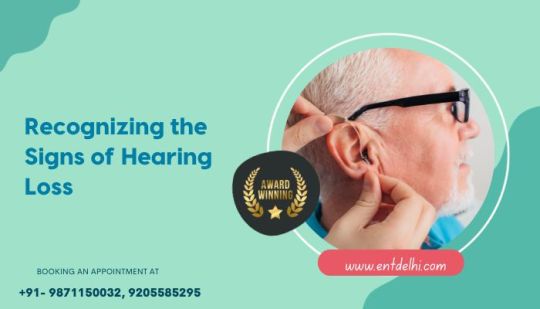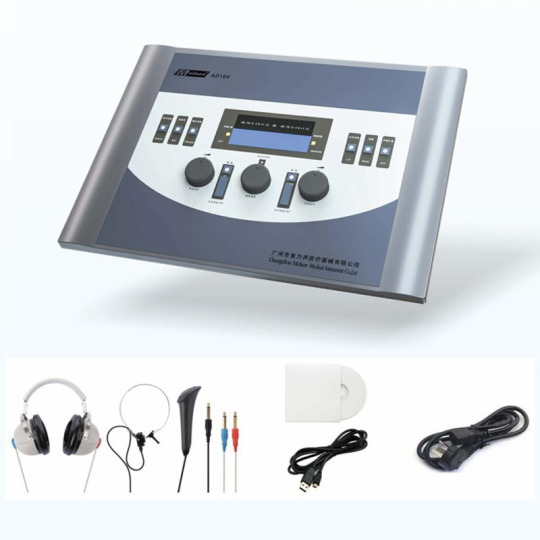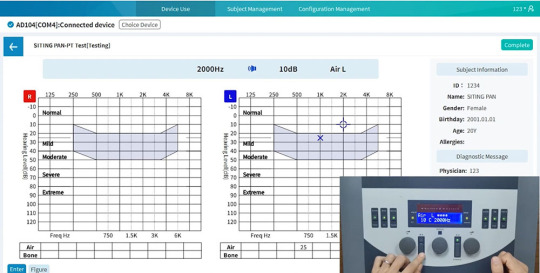#audiometry
Text
Jahan Hearing Aid Clinic: Comprehensive Hearing Healthcare Service
Jahan Hearing Aid Clinic is a leading provider of comprehensive hearing healthcare services, dedicated to improving the quality of life for individuals with hearing impairments. With a team of highly skilled audiologists and state-of-the-art technology, Jahan Hearing Aid Clinic offers a wide range of services, including audiology, hearing aids, and vertigo management.
Audiology Services
At جهان سمعک Hearing Aid Clinic, our audiology department is committed to providing accurate and thorough hearing assessments for patients of all ages. Our experienced audiologists conduct a variety of tests to evaluate hearing ability, including:
Pure-tone audiometry: This test measures hearing sensitivity across different frequencies, helping to identify the type and degree of hearing loss.
Speech audiometry: This assessment evaluates the patient's ability to understand and respond to speech at different volumes and in various environments.
Tympanometry: This test assesses the function of the middle ear and can help identify conditions such as fluid buildup or eardrum perforations.
نوار گوش: This non-invasive test measures the function of the inner ear, particularly the cochlea, and is often used for newborn hearing screening.
Our audiology team also provides comprehensive counseling and education to patients and their families, helping them understand their hearing loss and explore available treatment options.
Hearing Aid Services
Jahan Hearing Aid Clinic offers a wide selection of advanced hearing aid technologies to suit the unique needs and preferences of each patient. Our experienced کلینیک سمعک specialists work closely with patients to find the most appropriate device, taking into account factors such as lifestyle, budget, and specific hearing requirements.
Our hearing aid services include:
Hearing aid consultation: We provide in-depth consultations to discuss the various types of hearing aids available and help patients make informed decisions about قیمت سمعک.
Hearing aid fitting: Our specialists custom-fit and program hearing aids to ensure optimal comfort and performance, making adjustments as needed to achieve the best possible sound quality.
تعمیرات سمعک: We offer ongoing maintenance and repair services to keep hearing aids functioning at their best, including regular cleaning, battery replacement, and troubleshooting.
Assistive listening devices: In addition to hearing aids, we provide a range of assistive listening devices (ALDs) to enhance hearing in specific situations, such as watching television or participating in group conversations.
Our goal is to empower patients with the tools and support they need to overcome the challenges of hearing loss and improve their overall quality of life.
Vertigo Management
Jahan Hearing Aid Clinic also specializes in the diagnosis and management ofکلینیک سرگیجه, a condition characterized by a sensation of spinning or dizziness. Our team of experts uses advanced diagnostic techniques to identify the underlying cause of vertigo, which may include conditions such as benign paroxysmal positional vertigo (BPPV), Meniere's disease, or vestibular neuritis.
Our vertigo management services include:
Vestibular evaluation: We conduct comprehensive assessments of the vestibular system, which plays a crucial role in maintaining balance and spatial orientation.
Canalith repositioning maneuvers: For patients with BPPV, we perform specialized maneuvers to reposition the calcium crystals in the inner ear, helping to alleviate symptoms of vertigo.
Vestibular rehabilitation: We develop personalized rehabilitation programs to help patients with vestibular disorders improve their balance, reduce dizziness, and enhance their overall functional abilities.
Patient education and support: We provide extensive education and support to help patients understand their condition, manage their symptoms, and adapt to any necessary lifestyle changes.
At Jahan Hearing Aid Clinic, we are committed to providing the highest quality of care to our patients, combining advanced technology with compassionate, personalized service. Our goal is to be a trusted partner in your journey towards better hearing health and improved quality of life.
1 note
·
View note
Text
Hearing loss and tests
In this article, we will learn about the definition of deafness or hearing loss. We will discuss types of hearing loss, their causes, and much more.
Table of contents:
1. Introduction
2. Types
3. Causes
4. Hearing tests
5. Treatment
Hearing impairment is the inability to hear or the reduction in the hearing capacity of an average person.
Sound waves reach the cochlea in two ways:
1.…
View On WordPress
0 notes
Text

Understanding the Signs of Hearing Impairment
Hearing loss can quietly creep into one's life, affecting day-to-day interactions and quality of life. Recognizing these signs is crucial for timely intervention:
1. Repeated Requests for Repetition: Frequent requests for others to speak louder or repeat themselves may indicate hearing impairment, often more prevalent in older individuals.
2. Increasing Volume on Devices: If the TV or radio volume keeps rising, disturbing those around you, it's a clear signal to consider a hearing checkup.
3. Missing Everyday Sounds: Failing to hear common sounds like a ringing phone or doorbell is a hallmark of hearing loss, often perplexing household members.
4. Avoidance of Social Gatherings: Individuals with hearing loss may shy away from social events with multiple conversations, fearing they won't hear clearly, leading to isolation.
5. Unintentional Loud Speaking: When others comment on your loud speech, especially within your family, it might be linked to struggles in gauging your own volume.
Recognizing these signs is the initial step in addressing potential hearing loss. Seeking professional help from an Ear, Nose, and Throat (ENT) specialist is pivotal in diagnosing and managing the condition, ultimately enhancing one's overall quality of life. Don't let hearing impairment hold you back; take the first step towards a solution.
0 notes
Link
Understanding Tympanometry: A Comprehensive Guide to Ear Health Tympanometry is a valuable diagnostic tool used in the field of audiology and otolaryngology to assess the health and function of the middle ear. This non-invasive test provides essential insights into the condition of the ear and is commonly employed to diagnose various ear-related issues. In this comprehensive guide, we will delve into what tympanometry entails, how it works, and why it plays a pivotal role in maintaining ear health. [caption id="attachment_57954" align="aligncenter" width="640"] tympanometry[/caption] What Is Tympanometry? Tympanometry, often referred to as a "tympanogram," is a diagnostic procedure that evaluates the compliance and mobility of the eardrum, or tympanic membrane, as well as the pressure within the middle ear. It involves the use of a specialized device called a tympanometer, which emits varying air pressure levels into the ear canal while measuring the resulting changes in the eardrum's movement. These measurements are then graphically represented in a tympanogram. The Significance of Tympanometry Tympanometry serves multiple critical purposes in ear health assessment and diagnosis: Identifying Middle Ear Problems: Tympanometry aids in detecting various middle ear issues, such as fluid buildup (effusion), ear infections (otitis media), and eustachian tube dysfunction. By assessing the eardrum's response to pressure changes, healthcare providers can pinpoint the underlying problems. Evaluating Eustachian Tube Function: The eustachian tubes are responsible for equalizing air pressure between the middle ear and the external environment. Tympanometry can reveal any abnormalities in eustachian tube function, helping to diagnose conditions like barotrauma or chronic ear infections. Monitoring Middle Ear Health: Tympanometry is not only diagnostic but also useful for ongoing monitoring of middle ear health. It allows healthcare providers to track changes in ear conditions over time, ensuring timely intervention when needed. The Tympanometry Procedure: What Happens During the Test Tympanometry is a painless and straightforward procedure typically performed by audiologists or ear specialists. Here's what you can expect during a tympanometry test: Preparation: Before the test, the audiologist will ensure that your ear canal is clear of obstructions and wax. It's essential to have clean ear canals for accurate results. Instrument Placement: You will be comfortably seated, and a small, soft tip will be gently placed at the entrance of your ear canal. This tip contains a microphone and speaker, allowing the tympanometer to send and receive sound waves. Pressure Variations: The audiologist will introduce a series of air pressure changes into your ear canal. You may hear slight tones or feel pressure fluctuations. These variations are entirely normal and part of the test. Interpreting Tympanometry Results Understanding the results of a tympanometry test is essential in assessing ear health and diagnosing specific conditions. Here are some common tympanogram patterns and their interpretations: Type A Tympanogram: This is considered normal. It indicates that the eardrum and middle ear are functioning correctly. The peak of the tympanogram is within the normal pressure range. Type B Tympanogram: This pattern suggests the presence of middle ear issues, such as fluid buildup, infection, or eustachian tube dysfunction. Further evaluation is typically required to identify the specific problem. Type C Tympanogram: A Type C tympanogram indicates negative middle ear pressure, often associated with eustachian tube dysfunction. It may require monitoring or treatment to restore proper pressure. Diagnosing Ear Conditions with Tympanometry Tympanometry is instrumental in diagnosing various ear conditions. Here are some of the common conditions that can be identified through tympanometry: Otitis Media (Middle Ear Infection): Tympanometry can detect the presence of fluid in the middle ear, a hallmark of otitis media. Different tympanogram patterns may suggest acute or chronic infections. Eustachian Tube Dysfunction: When the eustachian tubes fail to equalize pressure properly, it can result in a Type C tympanogram. Tympanometry helps diagnose this dysfunction, which can lead to ear discomfort and hearing issues. Fluid Accumulation (Effusion): Effusion or the buildup of fluid in the middle ear can cause hearing problems, especially in children. Tympanometry can identify this condition and guide treatment decisions. The Role of Tympanometry in Ear Health Management Tympanometry is not only a diagnostic tool but also an essential component of ear health management. Here's why it plays a crucial role: Timely Intervention: By detecting ear conditions early, tympanometry allows for timely intervention. This can prevent issues from worsening and minimize discomfort. Treatment Monitoring: For individuals with chronic ear conditions like recurrent otitis media, tympanometry helps monitor treatment effectiveness and guides adjustments when necessary. Pediatric Ear Health: Tympanometry is especially valuable in pediatric care, where ear issues can impact language development and learning. Early detection and management are critical for children's well-being. Tympanometry FAQs 1. What is tympanometry? Tympanometry is a diagnostic test that assesses the health and function of the middle ear. It measures the compliance and pressure of the eardrum and can help diagnose various ear conditions. 2. Is tympanometry painful? No, tympanometry is generally painless. You may feel slight pressure changes and hear sounds, but it should not be painful. 3. Why might my doctor recommend tympanometry? Tympanometry is recommended to diagnose and monitor conditions like ear infections, fluid buildup in the middle ear, and eustachian tube dysfunction. 4. How long does a tympanometry test take? A tympanometry test typically takes just a few minutes to complete. 5. Can children undergo tympanometry? Yes, tympanometry is safe for children and is often used to assess their ear health. 6. What happens if I have a Type B tympanogram? A Type B tympanogram suggests middle ear issues. Further evaluation is needed to identify the specific problem. 7. Are there any preparations required before a tympanometry test? It's advisable to keep your ear canals clean. Inform your audiologist about any medications you're taking. 8. Can I eat or drink before a tympanometry test? Yes, you can eat and drink normally before the test. There are no dietary restrictions. 9. Are there any risks associated with tympanometry? Tympanometry is considered safe and carries minimal risks. It's a non-invasive procedure. 10. Can tympanometry diagnose hearing loss? While tympanometry provides valuable information about middle ear function, it primarily assesses conditions related to the middle ear, not sensorineural hearing loss. Additional tests may be needed to diagnose hearing loss. Conclusion: In conclusion, tympanometry is a powerful tool for assessing ear health, diagnosing conditions, and ensuring timely intervention. If you or a loved one is experiencing ear-related concerns, consult an audiologist or healthcare provider for a thorough evaluation and, if needed, a tympanometry test.
#Audiometric_test#Audiometry#Ear_drum_test#Ear_health_assessment#Ear_test_procedure#Eardrum_function_analysis#Middle_ear_function#Middle_ear_health_assessment#Middle_ear_pressure_test#Otitis_media_detection#Otitis_media_test#Otoacoustic_emissions#Tympanic_membrane_test#Tympanogram#Tympanogram_interpretation
0 notes
Text
Audiometry and Spirometry: Essential Tools for Occupational Health and Safety Compliance.

0 notes
Text

As a result of being busy, many individuals with hearing loss wait between 5 and 7 years before getting their hearing checked. Do something about it right away; putting it off can make fixing the issue more difficult.
.
Call Now: 022 -26105842 / +91-9322230036
.
Visit: http://calipsonic.com/
.
#Hearingaid#hearingaidaccessories#speechtherapy#hearingtest#disabilities#hearingaid#hearingissues#Hearingaidtreatment#Hearingaidclinic#ent#speechandaudiotherapy#speechimapirment#stammering#cochlearimplant#audiometry#infanthearingtest#testclinic#hearingcare#hearing#aid#treatment#Hearingtreatment#clinic#services#india#mumbai#calipsonic
0 notes
Text
Get The Best Audiometry Test in Singapore

A audiometry test evaluates a person's ability to hear throughout the entire speech spectrum. This test called an audiogram is used to identify the quietest sound that falls within the speech range. So if you are in need of the best audiometry test in Singapore, then AcuMed is the best choice. Visit our website.
0 notes
Text
Portable Diagnostic Audiometer AD104

The Portable Diagnostic Audiometer AD104 is a Pure Tone Audiometer, ideal for hearing screening work in schools, medical centers, hospitals, rehabilitation centers, enterprises, etc.

Test function: air conduction (AC), bone conduction (BC). Free sound field (SPK)
With a built-in microphone, easy to communicate with the tester.
With a standard USB 2.0 data interface, the audiometry data can be saved after connecting to the workstation. According to the National. The Occupational Health Standard of the People's Republic of China can analyze and generate professional noise diagnosis reports.
Custom report Logo and name can be set through the workstation, and an A4 or B5 format report can also be generated.
Frequency and maximum output intensity
FrequencyAC dB HLAC dB HLBC dB HLHzTDH39Ear-Tone 5AB711256060/2501001054550012011060750120115601000120120701500120120702000120120703000120120704000120115606000110100/800010095/
Audiometer AD104 Technical specifications
Channels:Two independent output channelsAir conduction:(1) Frequency: 125Hz~8000Hz; (2) Hearing level: -10~110dBBone Conduction:(3) Frequency: 250Hz~6000Hz. (4) Hearing level: -10~60dBThe allowable error of frequency:±2%Test Signal:Pure tone, Pulse, Warble tone, Narrow band noiseMicrophone:With a built-in microphone, easy to communicate with the testerDisplay screen:LCD display, Precise numerical displayDistortion factor:Air conduction is less than 2.5%, bone conduction is less than 5.5%Masking:Air conduction and Bone conduction Contralateral MaskingThe accuracy:Continuous attenuation/Step 5dB, error 1dBProtection Function:Protect the tester’s hearing from damage as far as possibleComputer interface:USB2.0 data transmission interface can be connected with PC for printing test reportOnline Diagnosis:Self-analysis and generation of occupational noise-induced hearing loss diagnosis report according to the “National Occupational Health Standards of the People’s Republic of China”Operating environment:Temperature 10°C~40°C, Relative humidity 30%~90%, Pressure 86 kPa~ 106 kPaWarm-up time:5 to 10 minutesMean time between failures≥1000hHost size:43cm*30cm*11cmPower adapter:input 100V-240V~50/60Hz 1.5A; Output DC 12V/4AOutput:TDH 39 Air Conduction Earphone, B71 Bone Conduction EarphoneSafety standard:GB 9706.1-2007 GB/T 14710-2009Audiometer reference standard:GB/T 7341.1-2010 JJG 388-2012Production license number:Guangdong Food and Drug Administration Production No.20091764Standard accessories:TDH39 Air Conduction Headset, B71 Bone Conduction Headset, Transponder, Power Cable, USB Data Cable, PC Software, Audiometer Aluminum Box
If you finish the payment today, your order will ship out within the delivery date.
Quantity (pieces)1 - 5> 5Est. Time (days)7To Be Negotiated
Read the full article
0 notes
Text

Discover the innovative IHS VRA Automated system at SonicEQ for precise auditory diagnostics. Enhance your practice with advanced Visual Reinforced Audiometry technology, streamlining assessments and ensuring accurate results. Visit us now for professional-grade diagnostic equipment.
#Visual Reinforced Audiometry#hearing screening equipment#screening audiometer#audiometer equipment#audiology equipment#newborn hearing screening equipment
0 notes
Text

Bluetooth Hearing Aids In Punjagutta
Signia Hearing Aids In Punjagutta. Our Centre is specialised for people who are suffering with Hearing problems, Speech and Language disorders and Psychological issues. Our main objective understands the problem of a client, based on a problem will go for different tests or assessments. Once tests are done will explain which service the client needs, it will be Hearing device, Speech therapy or Psychological counselling. Renew Hearing Center, Panjagutta is one of the best hearing aids centre in Hyderabad providing advance hearing loss treatment, digital Invisible hearing aids and Speech Theraphy or Psychological counselling. BTE Hearing Aids in Punjagutta.
0 notes
Text

Audiologist Australia
Victorian Hearing Offers A Wide Range Of Audiology Services For Hearing Loss, Hearing Checks & Hearing Tests In Geelong, Clayton & Balwyn, Melbourne, Australia
0 notes
Text

Audiometry Service | Audiometry Test in Singapore -QE Safety
Audiometry is important if you employ staff in a noisy working environment. QES offers an expert audiometry service across Singapore.
0 notes
Text
Crucial Work Of Audiometry Specialists And Why Their Expertise Is Essential
Hearing is a precious sense which helps the individuals to connect with others. However, hearing loss is a common and often underestimated condition. This is where the importance of Audiometry Specialist In Mulund becomes evident. These professionals play a vital role in diagnosing, managing, and improving the hearing health of individuals. Let's delve into the crucial work of audiometry specialists and why their expertise is essential.

Early Detection and Diagnosis: These specialists are trained to conduct comprehensive hearing assessments. They use various tests, including pure-tone audiometry, speech audiometry, and tympanometry, to evaluate a person's hearing abilities.
Tailored Treatment Plans: Once hearing loss is diagnosed, audiometry specialists collaborate with patients to develop personalized treatment plans.
Fitting and Adjustments: Audiometry specialists are experts in fitting and adjusting hearing aids and other assistive devices. They consider factors like the type and degree of hearing loss, lifestyle, and cosmetic preferences. Rehabilitation and Counseling: Living with hearing loss can be challenging, impacting not only the individual's ability to hear but also their overall well-being.
Protecting Against Further Damage: In addition to treating hearing loss, audiometry specialists emphasize the importance of hearing protection.
Lifelong Care: Hearing healthcare is an ongoing journey. Audiometry specialists provide continuous care, conducting follow-up assessments and making adjustments as needed.
The work of audiometry specialists is multifaceted and deeply impactful. They not only diagnose and treat hearing loss but also empower individuals to live their lives to the fullest. Anyone who is looking for the Best ENT Specialist In Mulund doesn’t have to search for it any further, as the best ones are associated with Dr. Jahnvi’s ENT Clinic & Be Well Polyclinic. If you suspect anyone with hearing loss, then you can seek guidance from the best doctors. Their work underscores the fact that hearing health is not just about the ears; it's about overall well-being and connection to the world.
About Dr. Jahnvi’s ENT Clinic & Be Well Polyclinic The clinic is owned by Dr. Jahnvi, and she is one of the renowned doctors who is known for providing a wide range of ENT treatments to everyone. The team of professionals who are working with the clinic never compromise the quality of the treatment and always ensure that the individual is getting the right set of treatment for their hearing disorders. To know more about the various types of treatment they offer, you can connect with them without any delay.
Source: https://penzu.com/p/d7f6fbcb8c68bb32
0 notes
Text
What is Audiometry Test
Audiometry is a procedure used to assess the sensitivity of a person's hearing across a range of frequencies. This test is typically performed by an audiologist using a machine called an audiometer.
Procedure of Audiometry Test
Here is a general description of how the audiometry test is done:
Preparation:
The patient is seated in a soundproof booth or room to ensure external noises don't interfere with the test.
The audiologist will often ask about the patient's medical and noise exposure history to get a better understanding of their hearing health.
Pure-Tone Audiometry:
The patient will wear headphones connected to the audiometer.
The audiologist will play a series of tones at various pitches (frequencies) and volumes (intensities) into one ear at a time.
The patient is asked to respond every time they hear a tone, usually by pressing a button.
The softest sound (in decibels, dB) that the patient can hear at each frequency is plotted on an audiogram, a graphical representation of hearing sensitivity.
The test will typically cover frequencies from 250 Hz to 8000 Hz, which encompasses most of the range of human speech and many environmental sounds.
Speech Audiometry:
The audiologist will play a series of words or sentences at various volumes.
The patient is asked to repeat the words or sentences.
This test assesses the individual's ability to hear and understand speech. The results can be presented as a speech reception threshold (SRT) and word recognition score.
Bone Conduction Testing:
Instead of using headphones, a bone oscillator is placed on the mastoid bone behind the ear.
This directly stimulates the inner ear, bypassing the middle and outer ear.
This test helps to determine if hearing loss is conductive (related to issues in the outer or middle ear) or sensorineural (related to issues in the inner ear or auditory nerve).
Tympanometry (if included):
A small probe is inserted into the ear canal.
The device changes the pressure in the ear and measures the movement of the eardrum in response to the pressure changes.
This test provides information about the condition and function of the middle ear.
Interpretation of Results:
After the tests, the audiologist will review the results with the patient.
The audiogram will show the type, degree, and configuration of any hearing loss.
Recommendations, which may include hearing aids, medical intervention, or other treatments, will be provided based on the results.
Follow-up:
Depending on the findings and recommendations, a follow-up might be needed with an Ear, Nose, and Throat (ENT) doctor, or for hearing aid fitting and adjustments.
Before undergoing an audiometry test, it's essential to avoid exposure to loud noises for at least 16 hours, as recent noise exposure can temporarily affect hearing thresholds. It's also a good idea to ensure the ears are free from excessive wax, as this can affect the test results.
Is Audiometry Test Painful?
No, the audiometry test is not painful. It is a non-invasive procedure that involves listening to sounds and responding when you hear them. Most people find the test straightforward and painless.
However, there are a few considerations:
Comfort Level: While the test is painless, some might feel slight discomfort or claustrophobia when seated in the soundproof booth, especially if the test takes a long time. This feeling is generally minor and goes away once the test is over.
Ear Pressure: If tympanometry is included, which assesses the middle ear's function by changing the air pressure in the ear canal, some might feel a sensation similar to being in an airplane when it's descending. While this isn't painful, it might feel a bit odd or uncomfortable for a brief moment.
Existing Ear Conditions: For individuals with active ear infections or other ear problems, inserting headphones or the probe for tympanometry might cause slight discomfort. It's essential to inform the audiologist of any current ear issues before the test.
If you ever feel discomfort during the test, you can inform the audiologist, and they can adjust or stop the test if necessary.
Audiometry Test in Jaipur
Lavanya Speech & Hearing Center performs audiometry test in Jaipur. We deal in all types of hearing aids - ordinary, digital. You can reach us directly for more details.
0 notes
Text
Audiometry and Spirometry: Essential Tools for Occupational Health and Safety Compliance.

0 notes